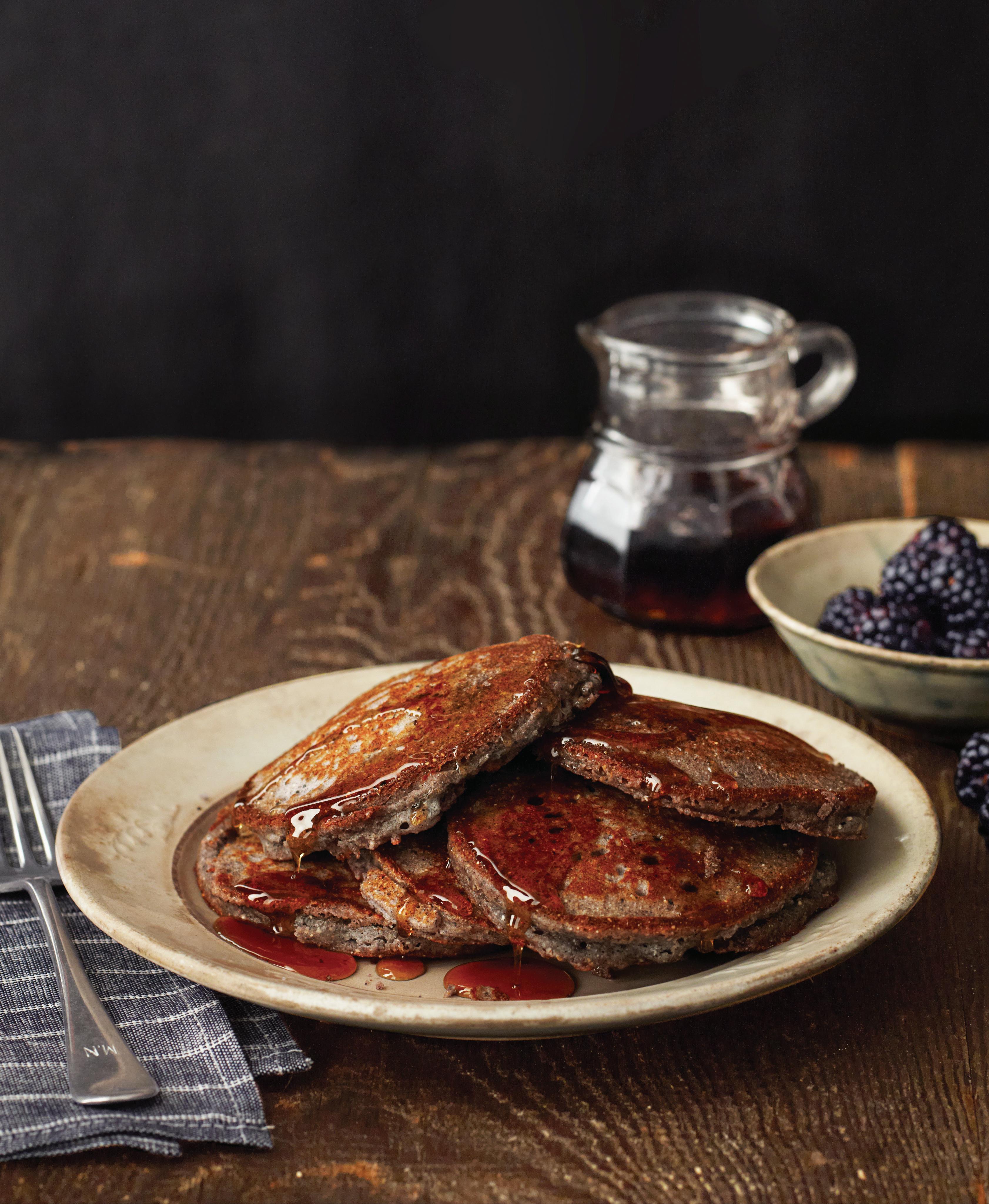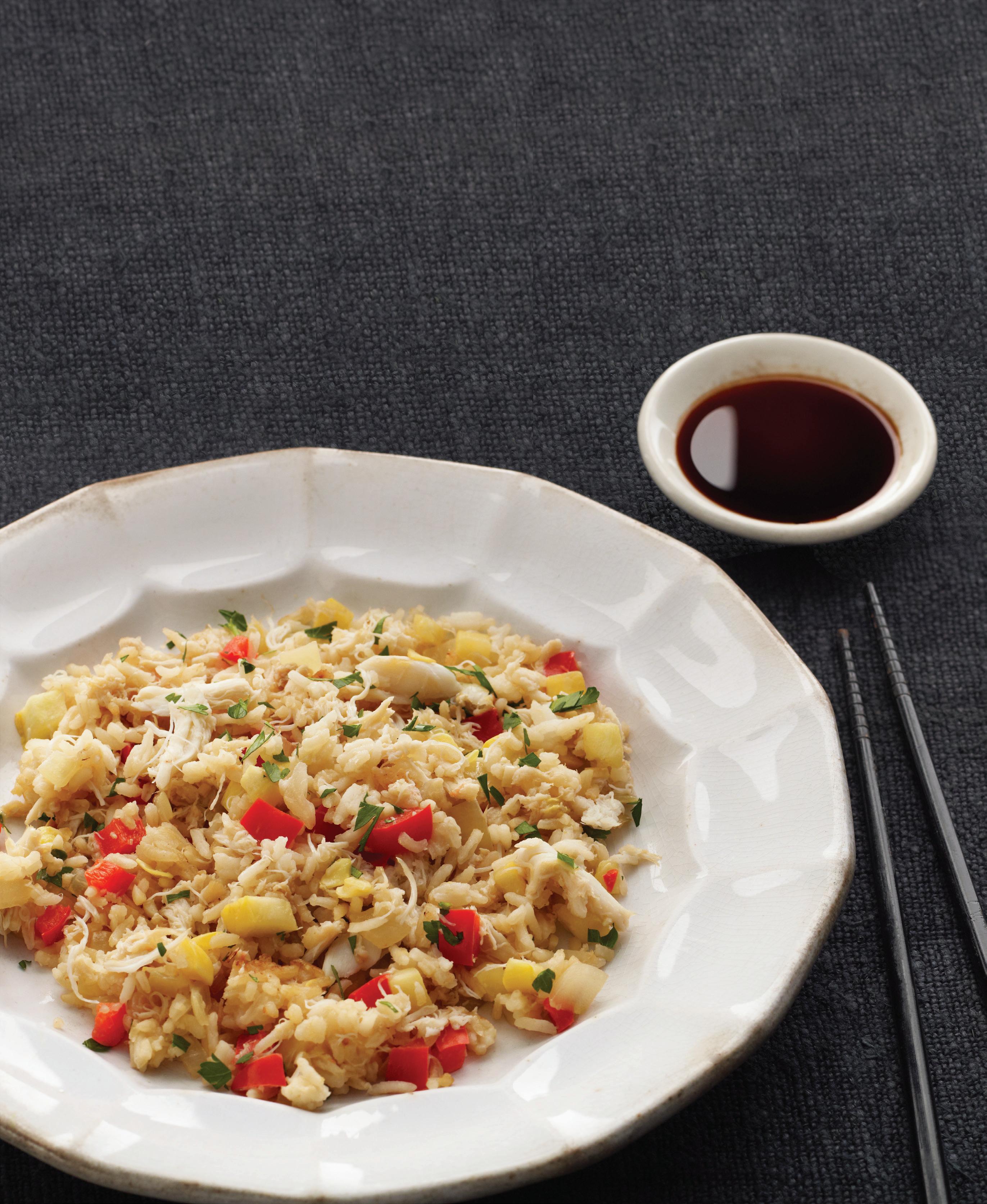
10 minute read
GONE WITH THE GLUTEN
Is gluten-free the way to be? NEW YOU investigates the growing phenomenon of people suffering from gluten sensitivity, and how limiting gluten exposure can potentially improve your health. Is it time to go against the grain?
BY JANETTE DAHER PHOTOGRAPHY BY WILLIAM BRINSON FOOD STYLING BY SUZANNE LENZER PROP STYLING BY STEPHANIE HANES
t ’ s a buzz - making phrase that has swept our nation, yet many consumers are wondering if “gluten-free” is simply the latest food fad. Step inside any corner store or supermarket and you’ll find a plethora of gluten-free products, while gluten-free menus are all the rage in restaurants around the globe. Is this a necessary function or simply today’s fashion?
Since the dawn of agriculture some 10,000 years ago, we as a society have always associated “bread” with “life.” Now we’re collectively asking whether the agricultural revolution created more problems than it solved. The undisputable truth of the matter is this: An alarming number of people are not able to eat bread due to gluten intolerance, and what was previously perceived as the gift of life may be acting as a slow-working toxin to a portion of our population. Chances are, you know someone who suffers from gluten sensitivity or full-blown celiac disease. And quite possibly, you yourself are unknowingly falling victim with every delicious bite.
Ingredients:
2 cups quinoa flour
½ cup sorghum flour
¾ cup almond meal
1 teaspoon baking soda
2 teaspoon ground cinnamon
1 cup coconut palm sugar
3 organic eggs
Directions:
½ cup olive oil
2 teaspoons vanilla extract
¼ cup orange juice
1 cup grated carrots
1 cup unsweetened coconut flakes
½ cup seedless dates
In a mixing bowl, mix together flours and dry ingredients. Add eggs, oil, vanilla, and orange juice. Beat to combine. Stir in carrots, coconut, and dates by hand.
Preheat the oven to 350 degrees. Pour the batter into the baking pan, and bake for about 25 to 35 minutes.

Blue Corn Pancakes

Ingredients:
1 ½ cups of blue corn meal
1 cup gluten free all-purpose flour
¾ cup almond flour
2 teaspoon baking powder
1 tablespoon baking soda
2 cups sugar
1 cup buttermilk
3 cups egg whites, whipped
Directions:
In a large bowl, mix together blue corn meal, flours, baking powder, baking soda, and sugar. Add buttermilk and egg whites. Mix together until smooth. Heat a large skillet over medium heat, and grease with a dab of oil or butter. Use about 2 tablespoons of batter for each pancake. Cook until golden. Serve immediately with maple syrup or your favorite syrup or jam.
Gluten 101
Gluten is a plant protein complex that exists in “grass” grains such as wheat, barley, and rye. The gluten complex is composed of two peptides, or large proteins: glutenin and prolamins. Prolamins are the toxic substances that trigger immune reactions in those who are gluten intolerant. Toxic substances include gliadin (found in wheat), secalin (rye), and hordein (barley). Gluten provides the structure and elasticity, which helps bread rise and gives our baked goods their chewy, fluffy texture. Gluten is found in bread, cookies, cakes, rolls, crackers, beer, cereal, and pasta. But gluten is also lurking in many processed foods such as frozen dinners, canned soup, ice cream, sauces, gravies, and many salad dressings.
The Gluten Effect
Why does gluten create a problem for some people and not for others? Humans were not actually designed to digest gluten. We lack many of the enzymes found in the stomachs, intestines, and pancreases of our livestock counterparts to fully digest gluten proteins. Gluten does not break down into small enough particles for successful digestion and absorption, leading to problems in the body.
Gluten acts like a toxin in the body of those who are sensitive by stimulating the release of the naturally occurring chemical known as Zonulin (pre-haptoglobin-2). Zonulin regulates the tight junctions in our intestinal wall, which normally prevent toxins from leaking into our bloodstream and lymphatics. Those sensitive to gluten have a high level of Zonulin which can cause the intestinal walls to open wide for five hours or longer causing intestinal issues.
“I liken this to a screen door in the height of mosquito season,” says Dr. Guy DaSilva, founder of the DaSilva Institute of AntiAging, Regenerative, and Functional Medicine in Sarasota, Florida. “Just as the screen allows air to pass through freely, but keeps out bugs and mosquitoes, the gut allows for nutrient absorption while blocking undigested food particles, toxins, and waste from entering the bloodstream. But when the gut, a typically impenetrable barrier, takes on the appearance of a screen door full of gaping holes, you have what is
Shopping Tips for Going G-Free on Any Budget
n Stick to whole foods like in-season fruits and vegetables as well as lean meats, all of which are naturally gluten-free.
n All kinds of rice and potatoes are naturally gluten-free, too, so stock up on sweet potatoes, baking potatoes, wild rice, and brown rice for healthy glutenfree sides that are also very budget -friendly.
n Shop your local ethnic supermarkets where you can find Mexican, Indian, or Thai foods that are naturally glutenfree. Think corn tortillas, rice, curry, and rice noodles.
known as ‘increased intestinal permeability,’ or ‘leaky gut.’ In short, your body is like a house filled with stinging insects.”
Unfortunately, it doesn’t stop there. Leaky gut then causes a war within your body as the immune system attacks these rogue toxins.
According to an article entitled, “Surprises
From Celiac Disease” from the August 2009 issue of Scientific American, leaky gut is found to be a major contributing cause of autoimmune disease. “Zonulin is a precursor to a protein marker, and is associated with the chromosome responsible for inflammatory or autoimmune diseases, such as lupus, rheumatoid arthritis, type 1 diabetes, and cancers—lymphoma, myeloid leukemia, breast, and prostate,” remarks DaSilva. Humans are the only mammals that possess this marker. Primates, who do not eat grain and who do not possess this marker, do not suffer from autoimmune disease.
Gluten Manifestations
Gluten intolerance manifests itself in three ways—celiac disease, wheat allergy, and non-celiac gluten sensitivity. Celiac disease occurs when undigested gluten enters the body, triggering a cascade of immunological reactions. This release of antibodies damages the villi (finger-like projections) of the intestines that absorb nutrients from food. As the villi become damaged, the body is unable to digest food. An estimated one in 133 Americans suffer from celiac disease, and incidence of the disease is on the rise.
A wheat allergy is a histamine response. Unlike gluten sensitivity or celiac disease, a wheat allergy elicits a rather immediate reaction such as hives, stomach pain, nasal con-
Top Retailers of Gluten-free Foods and Ingredients
n Bob’s Red Mill (bobsredmill.com): a premixed baking flour source n Mary’s Gone Crackers (marysgonecrackers.com): no-gluten crackers n Udi’s (udisglutenfree.com): Gluten-free bread, pizza, and cookies n Rudy’s Bakery (rudysbakery.com): Gluten-free bread n Crunchmaster (crunchmaster.com): Delicious crackers, totally g-free n Thai Kitchen (thaikitchen.com): Ready-to-eat or cook gluten-free Asian foods, rice noodles, and red and green curries n Rich’s (richs.com): Gluten-free pizza crusts, bread, and desserts n Lucy’s (drlucys.com): Gluten- and allergy-free cookies n Enjoy Life (enjoylifefoods.com): Gluten-free treats and cereals gestion, or even anaphylaxis—a very serious allergic reaction in which the throat closes. If left untreated, anaphylaxis can be fatal. Wheat allergies are seen as a type 1 hypersensitivity, and affects less than 1 percent of the US population.


Gluten intolerance or sensitivity may affect as many as one in 20 Americans, though the number is hard to pinpoint compared to celiac disease or wheat allergies. More than 100 symptoms have been linked to gluten sensitivity. (See our sidebar, “10 Signs of Gluten Sensitivity,” for the most common ailments associated with this condition.)

Unlike celiac disease, gluten sensitivity does not affect the lining of the intestine. Rather, the autoimmune reaction manifests in other parts of the body. A study published in the BMC Medicine comparing blood samples and intestinal biopsies of those with celiac disease and gluten sensitivity revealed that those with the latter had undamaged intestinal lining. Megan Roosevelt, RD, LD, the founder and CEO of Healthy Grocery Girl, LLC, explains that gluten intolerance differs from celiac disease in that “the body views gluten as an invader and elicits
Celiac Disease and Leaky Gut
Those with celiac disease may be prone to leaky gut syndrome because their gluten sensitivity has led antibodies to attack the lining of their small intestine. This often causes breaches in that wall, which allows food particles and bacteria in the gut to migrate into the bloodstream. The best way to fight leaky gut is to work on your gluten-free diet with a nutritionist who can guide you in choosing foods that won’t lead to bacterial overgrowth in the intestines. That overgrowth can easily be avoided by steering clear of processed foods.
10 Signs of Gluten Sensitivity
1. Digestive upset (gas, bloating, diarrhea)
2. Fatigue or brain fog
3. Autoimmune disorder (psoriasis, rheumatoid arthritis, ulcerative colitis)
4. Keratosis pilaris (skin rash on arms that looks like “chicken skin”)
5. Dizziness or loss of balance
6. PMS or infertility issues
7. Migraine headaches
8. Chronic fatigue or fibromyalgia
9. Swelling or pain in joints
10. Anxiety, depression, or ADD a response to fight the gluten with inflammation both inside and outside the digestive tract. Someone who is gluten intolerant does not have celiac disease, yet their health improves on a gluten-free diet and worsens again if gluten is eaten.”
Messing With Mother Nature
Why the rise in gluten sensitivity? “Celiac disease, a gastrointestinal manifestation of gluten sensitivity, has increased 400 percent over the last 50 years, according to The New England Journal of Medicine,” says Dr. DaSilva. According to The Journal of Agricultural and Food Chemistry , the amount of gluten in wheat products today is about 13 percent. Years ago, this gluten content in bread products was approximately 8 to 15 percent.
The answer to this question lies in the introduction of genetically modified wheat. In the 1950s, in an attempt to end world hunger, American agronomist Norman Ernest Borlaug began developing new varieties of wheat in Mexico that were resistant to diseases that plagued the crops. By 1962, he had cross-pollinated the wheat 8,156 times in just 15 years, a feat that would have taken nature thousands of years to accomplish. The end product consisted of six semi-dwarf, high-yield, disease-resistant wheat varieties. The media declared that it was going to save the world from starvation.
In 1970, this grain abundance, dubbed the “Green Revolution,” landed him the Nobel Peace Prize. Today, Borlaug’s wheat varieties dominate the entire US supply.
While ending world hunger is a noble endeavor, messing with the genetics of the food supply comes with its own set of problems. “Borlaug designed his wheat to have heavy heads of enlarged grains supported by thick, dwarfed stalks. This ‘dwarf’ wheat, was by definition, a mutation,” says Dr. DaSilva. “The wheat genes were drastically changed in a short amount of time, and our bodies simply haven’t had time to adapt.”
Testing For Gluten Sensitivity
If you think you have gluten sensitivity, a physician specializing in functional medicine can recognize the symptoms. One of the easiest ways to test yourself is to eliminate gluten for a two- to three-week period, then reintroduce foods containing gluten to see if you notice a difference.
There are also some blood tests available to determine celiac or gluten sensitivity. Clinical evidence shows that more than 90 percent of those diagnosed with celiac disease are positive for either the HLA-DQ2 or HLA-DQ8 genetic mutation. Blood tests for certain antibodies such as anti-gliadin (AGA), immunoglobulin A (IgA), or AGA-IgG are indicators of gluten sensi -

Fish Fried Rice
Ingredients:
3 tsp canola oil
2 cups yellow squash
4 cloves of fresh garlic, coarsely chopped
1 pound whiting, tilapia, or crab
1 cup red pepper, diced
Directions:
1 cup onion, diced
3 cups pre-prepared, gluten-free white or brown rice
Salt and pepper, to taste
½ cup gluten-free soy sauce

Handful of parsley, freshly chopped
Add oil to skillet, and sautée squash and garlic for 3 minutes. Add all vegetables and fish, and sautée until cooked through. Add rice and seasoning. Top with soy and parsley.
Recipe provided courtesy of Chef Kimberly Fonville, KF Culinary Designs, LLC

Roasted Spaghetti Squash
Ingredients:
1 spaghetti squash
1 tablespoon olive oil
1 teaspoon garlic, cloves or powder
1 small onion, finely chopped
2-3 chopped tomatoes
¾ cup feta or goat cheese
¼ cup basil leaves
Directions: tivity. Gluten sensitivity studies conducted by the University of Maryland’s Center for Celiac Research found that almost half of those individuals diagnosed with gluten intolerance tested positive for these two antibodies. Food sensitivity for gluten can also be determined using a blood test that detects certain food allergies. A combination gut health profile test, which encompasses all these parameters, is available from Cell Science Systems (located in South Florida) and can be ordered by your physician.
Cut spaghetti squash in half. Place cut sides down on a baking sheet. Bake at 350 degrees for 30 minutes. In the meantime, sautée olive oil, garlic, onion, and tomatoes on medium heat. Stir until warm. Let simmer on low heat while you carve out the spaghetti-like fibers in the squash. (Remove seeds and discard, or save for later use.)
Toss all ingredients together in a bowl or serve in the carved out squash for an extra festive look.
Another option is stool testing. Dallas-based EnteroLab offers a self-test for anti-gliadin antibodies. EnteroLab’s founder, Dr. Kenneth Fine, is a gastroenterologist who developed the test. He believes that measuring the antibodies coming directly from the intestinal tract is a more accurate measurement for gluten sensitivity than monitoring the bloodstream.
Treating Gluten Sensitivity

Unfortunately, there is no magic pill or treatment to cure celiac disease or gluten sensitivity. The best treatment strategy is strict avoidance of any and all products containing gluten. This is best achieved by avoiding all bread or baked goods, pasta, and many processed foods. As with any lifestyle change, our experts agree that savvy supplementation is important whenever a person goes gluten-free. Some nutrients that may become depleted when an individual eliminates gluten from his or her diet include B vitamins, fiber, and iron.
“Eating a diet rich in whole, plant-based foods is an optimal choice for those who eat gluten-free,” says Roosevelt. “There are many whole, plant-based foods that are naturally gluten-free like brown rice and quinoa, beans, nuts, seeds, fruits, and vegetables.”
The smart avoidance of gluten seems to be much more than a trend. Research shows that the modern American diet—rich in wheatbased glutinous foods—is increasingly wreaking havoc on our health. Not everyone suffers from gluten sensitivity, but if you are experiencing persistent health concerns that don’t go away with conventional medical treatment, “going against the grain” and giving up gluten can potentially heal the things that ail you. l










